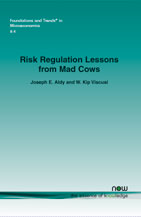Risk Regulation Lessons from Mad Cows
By Joseph E. Aldy, John F. Kennedy School of Government, Harvard University, USA, joseph_aldy@hks.harvard.edu | W. Kip Viscusi, Vanderbilt University Law School, kip.viscusi@vanderbilt.edu
Abstract
The mad cow disease crisis in the United Kingdom (U.K.) was a major policy disaster. The government and public health officials failed to identify the risk to humans, created tremendous uncertainty regarding the human risks once they were identified, and undertook a series of policies that undermined public trust. In contrast, the mad cow disease risk never became a major problem in the United States (U.S.). The lead time that the U.S. had in responding to the disease that was first identified in the U.K. assisted in planning the policy response to avert a crisis. The absence of a comparable U.S. crisis, however, does not imply that the U.S. risk management approach was a success. Until recently, there was no systematic assessment of the domestic risks of mad cow disease. Moreover, U.S. government agencies have never undertaken a comprehensive assessment of the benefits and costs of any U.S. regulation dealing with mad cow disease. The absence of a sound economic basis for policy is reflected in the United States Department of Agriculture's (USDA) ill-considered decision to prohibit the private testing of beef for mad cow disease. This decision disadvantaged companies that sought such testing in order to comply with foreign testing regulations. In the absence of such testing, U.S. beef exports plummeted. One company that attempted to implement a testing program launched a legal challenge to the USDA prohibition and was unsuccessful. The policy failures in both the U.K. and the U.S. provide several lessons for regulating invasive species risks and dealing with emerging risks more generally. We conclude with a series of ten public policy lessons for dealing with similar emerging risks.
Risk Regulation Lessons from Mad Cows
Risk Regulation Lesson from Mad Cows analyses and compares the policy responses in the United Kingdom (U.K.) and the United States (U.S.) to the mad cow disease crisis. Although there was not nearly as many deaths related to Creutzfeldt-Jakob disease (vCJD) and bovine spongiform encephalopathy (BSE) as scientist had predicted, the U.K. mad cow experience is widely regarded as a major policy debacle. The authors review the policy failures in the U.K., and also explain why the absence of comparable crisis in the U.S. does not signal that the mad cow experience has been a U.S. policy success story. This monograph draws a number of lessons from the mad cow experience regarding how one should regulate invasive species risks and deal with dimly understood but potentially serious risks to large populations.
Risk Regulations Lesson from Mad Cows is organized as follows. After a brief Introduction, Section 2 examines the nature of risks to animals and humans from BSE and vCJD. Section 3 presents a mainstream public policy framework to evaluate the welfare consequences of BSE and vCJD risk mitigation instruments. Section 4 examines how other governments have conceptualized the risks for policy purposes. After providing a chronology of the policy events and policy actions in Section 5, the authors examine issues pertaining to media coverage and risk communication in Section 6. Consumer responses to the informational environment are reviewed in Section 7, and governments' use of trade policy in Section 8. A controversial effort by one beef producer to have its beef certified as being BSE-free brings together a wide set of cross-cutting issues of risk communication, government regulation, litigation, and international trade, and will serve as the main policy case study in Section 9. Lastly, in Section 10 the authors conclude with a review of general lessons for regulatory policy learned from the crisis.
